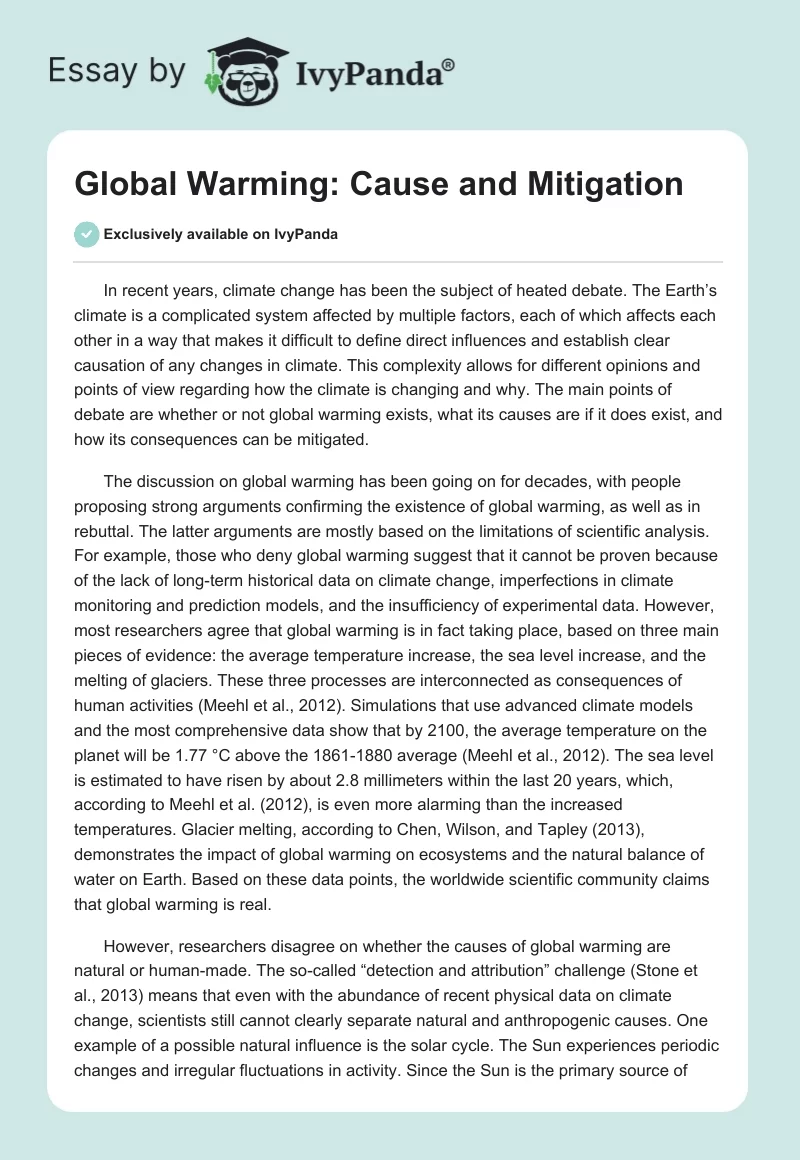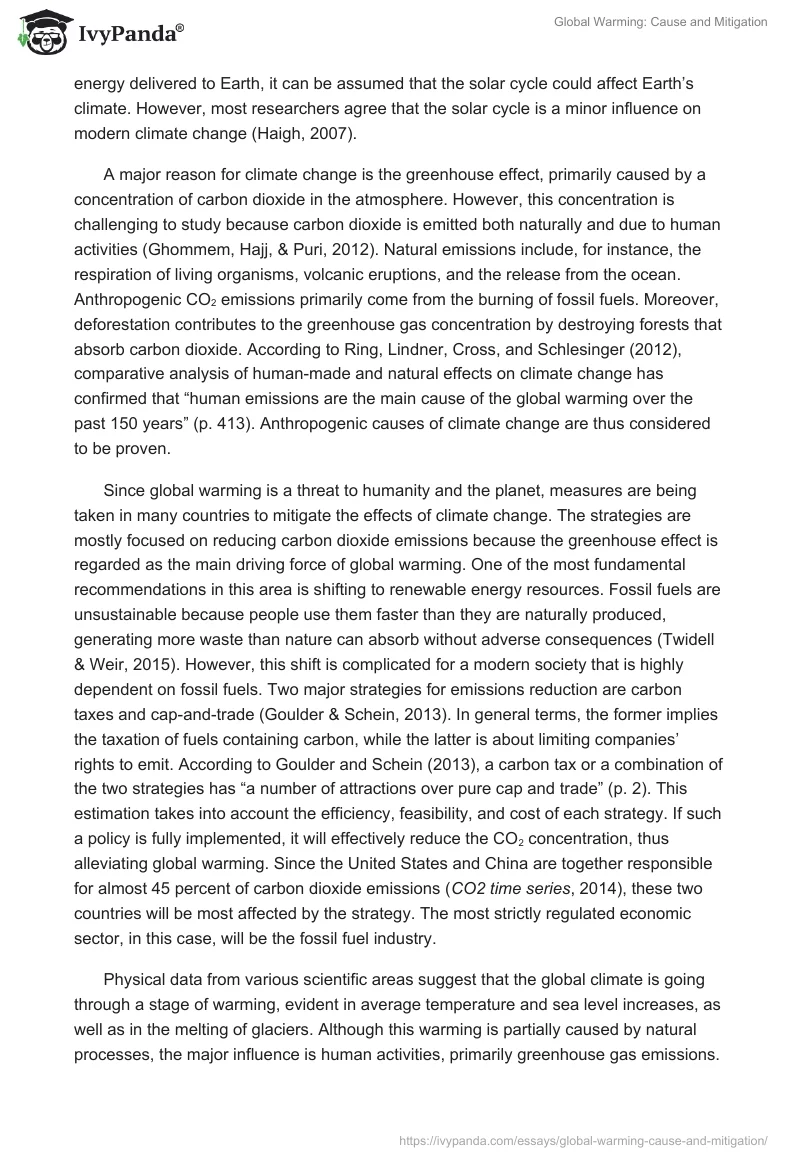In recent years, climate change has been the subject of heated debate. The Earth’s climate is a complicated system affected by multiple factors, each of which affects each other in a way that makes it difficult to define direct influences and establish clear causation of any changes in climate. This complexity allows for different opinions and points of view regarding how the climate is changing and why. The main points of debate are whether or not global warming exists, what its causes are if it does exist, and how its consequences can be mitigated.
The discussion on global warming has been going on for decades, with people proposing strong arguments confirming the existence of global warming, as well as in rebuttal. The latter arguments are mostly based on the limitations of scientific analysis. For example, those who deny global warming suggest that it cannot be proven because of the lack of long-term historical data on climate change, imperfections in climate monitoring and prediction models, and the insufficiency of experimental data. However, most researchers agree that global warming is in fact taking place, based on three main pieces of evidence: the average temperature increase, the sea level increase, and the melting of glaciers. These three processes are interconnected as consequences of human activities (Meehl et al., 2012). Simulations that use advanced climate models and the most comprehensive data show that by 2100, the average temperature on the planet will be 1.77 °C above the 1861-1880 average (Meehl et al., 2012). The sea level is estimated to have risen by about 2.8 millimeters within the last 20 years, which, according to Meehl et al. (2012), is even more alarming than the increased temperatures. Glacier melting, according to Chen, Wilson, and Tapley (2013), demonstrates the impact of global warming on ecosystems and the natural balance of water on Earth. Based on these data points, the worldwide scientific community claims that global warming is real.
However, researchers disagree on whether the causes of global warming are natural or human-made. The so-called “detection and attribution” challenge (Stone et al., 2013) means that even with the abundance of recent physical data on climate change, scientists still cannot clearly separate natural and anthropogenic causes. One example of a possible natural influence is the solar cycle. The Sun experiences periodic changes and irregular fluctuations in activity. Since the Sun is the primary source of energy delivered to Earth, it can be assumed that the solar cycle could affect Earth’s climate. However, most researchers agree that the solar cycle is a minor influence on modern climate change (Haigh, 2007).
A major reason for climate change is the greenhouse effect, primarily caused by a concentration of carbon dioxide in the atmosphere. However, this concentration is challenging to study because carbon dioxide is emitted both naturally and due to human activities (Ghommem, Hajj, & Puri, 2012). Natural emissions include, for instance, the respiration of living organisms, volcanic eruptions, and the release from the ocean. Anthropogenic CO2 emissions primarily come from the burning of fossil fuels. Moreover, deforestation contributes to the greenhouse gas concentration by destroying forests that absorb carbon dioxide. According to Ring, Lindner, Cross, and Schlesinger (2012), comparative analysis of human-made and natural effects on climate change has confirmed that “human emissions are the main cause of the global warming over the past 150 years” (p. 413). Anthropogenic causes of climate change are thus considered to be proven.
Since global warming is a threat to humanity and the planet, measures are being taken in many countries to mitigate the effects of climate change. The strategies are mostly focused on reducing carbon dioxide emissions because the greenhouse effect is regarded as the main driving force of global warming. One of the most fundamental recommendations in this area is shifting to renewable energy resources. Fossil fuels are unsustainable because people use them faster than they are naturally produced, generating more waste than nature can absorb without adverse consequences (Twidell & Weir, 2015). However, this shift is complicated for a modern society that is highly dependent on fossil fuels. Two major strategies for emissions reduction are carbon taxes and cap-and-trade (Goulder & Schein, 2013). In general terms, the former implies the taxation of fuels containing carbon, while the latter is about limiting companies’ rights to emit. According to Goulder and Schein (2013), a carbon tax or a combination of the two strategies has “a number of attractions over pure cap and trade” (p. 2). This estimation takes into account the efficiency, feasibility, and cost of each strategy. If such a policy is fully implemented, it will effectively reduce the CO2 concentration, thus alleviating global warming. Since the United States and China are together responsible for almost 45 percent of carbon dioxide emissions (CO2 time series, 2014), these two countries will be most affected by the strategy. The most strictly regulated economic sector, in this case, will be the fossil fuel industry.
Physical data from various scientific areas suggest that the global climate is going through a stage of warming, evident in average temperature and sea level increases, as well as in the melting of glaciers. Although this warming is partially caused by natural processes, the major influence is human activities, primarily greenhouse gas emissions. Different strategies can be adopted to reduce the emissions, including imposing limitations on the fossil fuel industry with the ultimate goal to use renewable energy instead of oil, gas, and coal. Overall, the majority of the global community has recognized the threat of climate change and understands the need to mitigate its adverse effects.
References
Chen, J. L., Wilson, C. R., & Tapley, B. D. (2013). Contribution of ice sheet and mountain glacier melt to recent sea level rise. Nature Geoscience, 6(7), 549-552.
CO2 time series 1990-2014 per region/country. (2014). Web.
Ghommem, M., Hajj, M. R., & Puri, I. K. (2012). Influence of natural and anthropogenic carbon dioxide sequestration on global warming. Ecological Modelling, 235(1), 1-7.
Goulder, L. H., & Schein, A. (2013). Carbon taxes vs. cap and trade: A critical review. Web.
Haigh, J. D. (2007). The Sun and the Earth’s climate. Living Reviews in Solar Physics, 4(1), 1-64.
Meehl, G. A., Hu, A., Tebaldi, C., Arblaster, J. M., Washington, W. M., Teng,…White, J. B. (2012). Relative outcomes of climate change mitigation related to global temperature versus sea-level rise. Nature Climate Change, 2(8), 576-580.
Ring, M. J., Lindner, D., Cross, E. F., & Schlesinger, M. E. (2012). Causes of the global warming observed since the 19th century. Atmospheric and Climate Sciences, 2(04), 401-415.
Stone, D., Auffhammer, M., Carey, M., Hansen, G., Huggel, C., Cramer, W.,…Yohe, G. (2013). The challenge to detect and attribute effects of climate change on human and natural systems. Climatic Change, 121(2), 381-395.
Twidell, J., & Weir, T. (2015). Renewable energy resources. New York, NY: Routledge.



